|
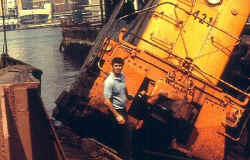 The anecdote from the LIRR Brakeman who was on the job
that day; as told to JJ Earl: "It was still daylight when we had coupled up to the first car on the float.
I then swung down off the float flat (reacher car) to get between the flat and the first car and bent down to hang the (air) hose when
I heard this loud noise. I jumped up and looked around and saw the engine starting to tilt and the float under
my feet start to move. The anecdote from the LIRR Brakeman who was on the job
that day; as told to JJ Earl: "It was still daylight when we had coupled up to the first car on the float.
I then swung down off the float flat (reacher car) to get between the flat and the first car and bent down to hang the (air) hose when
I heard this loud noise. I jumped up and looked around and saw the engine starting to tilt and the float under
my feet start to move.
I didn't know that I could move so fast but when it all settled down,
I was safely out of the way.
When the new Trainmaster on duty came to the scene, he asked me, "How fast were you
going?" This was the standard question asked at all mishaps, found
on page one of the New Trainmaster's Handbook. "We were standin' still" was
my reply. "Aww! Bull---t" came the bellow of the
Trainmaster. Words got a little testy until everyone understood that this was the boss.
To make a long story short, no one was injured, no one was disciplined,
#5 Bridge was put out of service and Alco S1 #421 was cut up for scrap ( there were new engines on order
anyhow.) It wasn't long afterward that all floating operations came to halt with the advent of
Conrail." Provided
compliments of JJ Earl. |
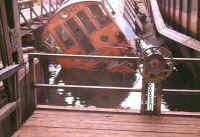
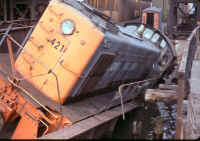
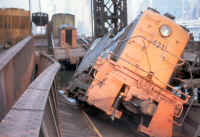
Failing apron on #5 bridge - S1 #421
Photos/Archive/Info: JJ Earl
|
|
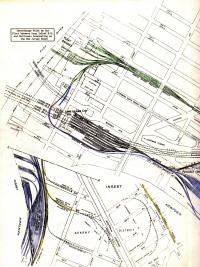 According
to some old timers, many years ago, 3 & 4 bridges were just south of 1
& 2. Tracks leading to them were retained and used for set-outs of
cars to be picked up later. These were not "overhead bridges" as
we know them but were but were floated on pontoons rather than by
motorized lift. The pontoon bridge is much like the Cross Harbor's. According
to some old timers, many years ago, 3 & 4 bridges were just south of 1
& 2. Tracks leading to them were retained and used for set-outs of
cars to be picked up later. These were not "overhead bridges" as
we know them but were but were floated on pontoons rather than by
motorized lift. The pontoon bridge is much like the Cross Harbor's.
East River Float Dock Area -
LI City
|
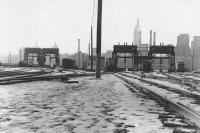
LI City Float Docks 1,2,3 & 4
looking west. Photo & Collection: Dave Keller
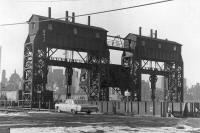
LI City Float Docks 1-71
Photo & Collection: Dave Keller |
|
The float job would unload
the floats and bring the cars to Jackson Ave. Another job called the 3rd
float would then bring the cars up the feeder track and drop them for the
hump job.
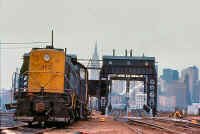
RS1 #463 11/28/1975 Photo: Tim Darnell
The hump job would switch
the cars into the proper tracks for their destination, the haulers to
Holban Yard taking cars bound for Long Island, the road MA jobs and the
yard jobs, ( Degnon, Kearny, Murrers and Blissville jobs ). Past the hump
was a few private sidings, Gallo, Ronzoni, old GE and the Harold Ave. team
yard witch was switched by the last trick Harold Ave. job.
Add The Freight House
job. They worked from 8th street to Harold Ave servicing sidings along
"The Stink" track. Info: JJ Earl
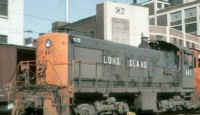
LIRR #441 Alco S-2 at West Chemical 02/1967
West Chemical made CN disinfectant cleaner (Motto: "You can't spell clean without CN"). CN was an iodine-containing product sort of like Betadine lotion, but it was made with industrial-grade ingredients instead of pharmaceutical-grade. As a result it smelled of iodine with a strong overtone of dead fish. Stink track, indeed!
Albert Waltien
On the other end of the hump yard at Thompson Ave. was the Yard A job
which kicked out cripples, double over tracks to make up trains and did
other yard work. Going back towards the river was the 8th Street hump
where the westbounds were switched out by the Hill job for the railroads
that they were going to.
|
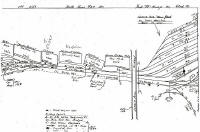
Feeder track and hump Emery Maps
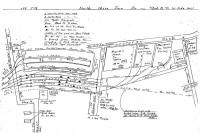
Gallo, Ronzoni, old GE and the
Harold Ave. team yard switch
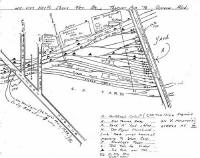
Thompson Ave. and Yard A
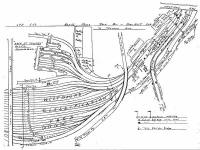
LI City team yard and freight house
|
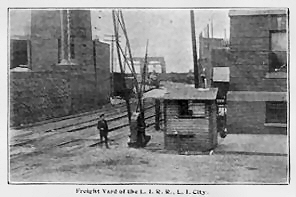
Jackson Ave Crossing
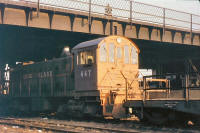
Alco S2 #447 with Idler (reach) car
Photo: Steve Hoskins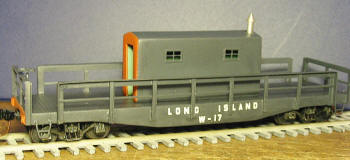
W17 Idler Car
Model/Photo: Steve Hoskins
Then the float job would load the westbounds on car
floats to be ferried by the railroads that were handling the cars. Along
side of the 8th St. hump was the LI City team yard and freight house. I hope
this answers your question, I don't remember all the correct job symbols (
float 1, float 2, 8th St. Hill etc. ) but that's what we called them.
Info: Joe Falco
|
|
Q: I’m curious as to when and why the LIRR started to
classify freights twice – once in the Northshore yards, sending Long
Island bound freight to Holban, just to be reclassified for Greenport,
Montauk, Port Jeff, etc. Did the North Shore
Yards / Yard A exist when the East River tunnels were built or were they
built as part of the Penn’s Sunnyside yard complex?
Before the Penn Station tunnels were built, the current mainline saw the
bulk of the freight into and out of Long Island City, with the Montauk
Division carrying the passenger trains. I know there used to be a large
freight yard west of the old Jamaica station. When the current Jamaica
station was built, the freight yard was moved to Hollis / St Albans (Holban
yard). When the old Jamaica freight yard was operating, did that yard
classify all freights or were there always two yards? Thanks in advance.
Johnny F.
--------------------------------------------------------------------------------
A: When I worked at Yard A in the late fifties / early sixties, tracks 1-9
were called the “OLD YARD” and tracks ten and above were called “NEW
YARD”. I mention this, because from articles that I have read concerning
the
building of the tunnels and Sunnyside yard, there was a great deal of
improvement done for the LIRR, including the building of Holban Yard. This
was in conjunction with the building of Hell Gate Bridge, the NY
Connecting railroad
and installation of freight receiving stations on the island.
The Degnon Construction Co., when finished their work with the tunnels and
Sunnyside, built warehouses along 47th Ave and created Degnon Terminal
with rail access to each.
Other terminals in the area were created at this time (Kearny, MUrrer,
Harold Ave, Arch Street, etc.) and this would cause too much congestion in
the North Shore Yard without sending Island bound freight to a point east
of Jamaica to be re-classified for east end destinations.
During the 50s/60s, there were three road jobs that worked around the
clock taking two trains each of approximately sixty cars from Yard A to
Holban, clearing the yard for more cars to be switched.
Having east end jobs start and terminate east of Jamaica also relieved the
dispatchers in Jamaica from having to route these east end freights
through the Jamaica bottleneck to get to or from Yard A.
Another consideration was the 16 hour law. Crews could have outlawed if
they had to do that extra eleven miles with traffic tie-ups that they
would encounter.
This explanation is from what I have read in articles (I don’t remember
where) and from my own experience in the workings of the railroad during
the period that I mention. I hope it answers your question.
JJ Earl
--------------------------------------------------------------------------------
A: In my time, Yard A classified trains for numerous switch jobs in the
Long Island City area (Degnon, Bliss, etc) and freight for east of
Jamaica.
The freight for east of Jamaica was made up for haulers to be transferred
to Holban Yard where it was again classified for East bound freights.
Freight was also made up in Yard A for transfer to Fresh Pond for New
Haven interchange and some local switching jobs in that area.
This all started with freight from the float bridges in Long Island City
which received cars from many railroads in the area. In other words, New
York harbor was like a huge classification yard. Amazing that this is all
gone. Worked many days at the float bridges in LI City. There cars were
taken off and sent by the feeder job to the hump at the East end of Yard A
and were classified as above. The Hump at 8th. street classified westbound
cars ,generally empties, in tracks according to the home roads of the cars
to be loaded on floats.
I am not familiar with any large freight yard West of Jamaica. Before my
time. I remember a team yard in Richmond Hill and Johnson Ave yard behind
Hall tower with leads to the Dunton Shops.
As to Penn. Station and Sunnyside.
What I believe came about was that the Long Island Rail Road had talked of
tunneling into Manhattan but did not have the funds, but did have the
rights to do so as it had the waterfront property on the East river. I
think the Pennsy and the New Haven formed the New York Connecting Railroad
to build the Hell Gate bridge and the tunnels. LIRR evidently did not have
the funds.
As to Sunnyside it must have acquired the property and built the Yard in
the same time period. With the loop it was a smart move as Penn Station
does not have much layup room. Too bad the same thing was not done in
Jersey for the LIRR.. Reverse moves in Penn Station tied up tracks that
could be used quicker. Many times it was hard to get to the other end of
the train in the rush hour as passengers were trying to get off the train.
Mark Smith - Retired Engineer |